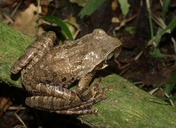|
Boophis obscurus (Boettger, 1913)
Subgenus: Boophis | family: Mantellidae subfamily: Boophinae genus: Boophis |
| Species Description: Boettger, O. (1913). "Reptilien und Amphibien von Madagascar, den Inseln und dem Festland Ostafrikas." Voeltzkow, A. ed., Reise in Ost-Afrika in den Jahren 1903–1905 mit Mitteln der Hermann und Elise geb. Heckmann-Wentzel-Stiftung. Wissenschaftliche Ergebnisse. Systematischen Arbeiten. Volume 3, No. 4: 269–376. Stuttgart, E. Schweizerbart. | |
|
Taxonomic Notes: Revalidated by: Glaw F, Koehler J, de la Riva I, Vieites DR, Vences M (2010) "Integrative taxonomy of Malagasy treefrogs: combination of molecular genetics, bioacoustics and comparative morphology reveals twelve additional species of Boophis." Zootaxa 2382:1-82. |
|
 © 2015 Devin Edmonds (1 of 2) |
|
|
|
Description As a Boophis, this genus has an intercalary element between the ultimate and penultimate phalanges in the fingers and toes, nuptial pads, absence of femoral and gular glands in males, enlarged terminal discs at the fingers and toes, lateral webbing on the metatarsalia, absence of outer metatarsal tubercle, and overall similarity to other Boophis species. It is then assigned to the group Boophis goudoti based on moderate to large sizing, brownish dorsal color, non-transparent ventral skin, single subgular vocal sac, vomerine teeth, webbing between fingers, sharp canthus rostralis, and molecular phylogenetic relationships according to Glaw et al. (2010). However, it is distinguished from this group due to genetic differentiation. There are various other species in Boophis such as B. boehmei, B. rufioculis, and more. Yet, it differentiations itself from these through its larger size and the colors of the iris. The iris does not have red coloring, dark stripes, or blue coloring on the periphery seen in other Boophis species. Also, in many of the Boophis species, there are distinct dermal flaps or tubercles on the heels. Boophis obscurus lacks these. Also, this species is similar to B. periegetes, but they can be differentiated through different skin types, such as containing keratinized spicules rather than large warts and through their advertisement calls. The advertisement calls of B. obscurus contains irregular pulsed croaking (Glaw et al. 2010). In life, the dorsum is reddish-brown, the flanks are yellow but transition to a blush as they move towards the hips. The dorsum is marked with irregular brown blotches. The ventrum is creamy white with brown markings. The limbs may have orange bars. In preservative, the dorsum color does not change much. The upper lip displays an unconnected cream stripe. Grey warts with tiny black spicules become apparent. The flanks become brown with irregular cream-colored blotches. The legs have dark brown bars. The ventrum becomes beige with brown blotches. The iris of Boophis obscurus are a pale orange (Glaw et al. 2010). There are no remarkable variation in color and pattern in the males from Ranomafana. However dorsal spicules vary in their distinctiveness and the female specimen lacked spicules altogether (Glaw et al. 2010). Distribution and Habitat Country distribution from AmphibiaWeb's database: Madagascar
Life History, Abundance, Activity, and Special Behaviors Vocalization among B. obscurus are variable and contain different call types. However, not enough information has been found on the classification of these call types. One of these calls is assumed to be an advertisement call that is at high energy and regular structure. The call is characterized with a pulsed note with temporal modulation of pulses. Note durations are 137 – 238 ms, repeated at irregular intervals with 8 pulses per note. The intervals between pulses range between 4 – 41 ms and decrease toward the end of the note. The pulse repetition rate varies between 20 – 70 pulses/second. The dominate frequency range is 400 – 3000 Hz. A second call is somewhat similar but is softer more evenly distributed pulses. The note duration is 206 – 360 ms and repeated irregularly with 8 – 16 pulses per note. The interpulse interval is 9 – 25 ms and repletion rate is about 32 – 36 pulses/second. The dominant frequency range is 400 – 1800 Hz. A third type of call contains various single clicks and shorter pulsed notes, but detailed analysis of the call was not possible. These three calls do not seem to follow a pattern and are randomly mixed and combined (Glaw et al 2010). The reproduction of B. obscurus occurs in streams (Pabijan et al 2012). Trends and Threats Comments The molecular phylogeny places this species in the same clad as Boophis goudoti. The divergences are 2.1-3.9% depending on the length of the fragment. One specimen morphologically belonging to B. obscurus has a sequence identical to B. goudoti indicated incomplete lineage sorting or recent hybridization (Glaw et al. 2010). Boophis obscurus is one of the first species of frogs identified in Madagascar (Glaw et al. 2010). This species name is resurrected from Boettger (1913), who named the species, Rhacophorus obscurus (Glaw et al. 2010). Boophis obscurus is synonymous with Boophis goudoti and Rhacophorus obscurus (Glaw et al. 2010).
References
Glaw, F., Kohler, J., De La Riva, I., Vieites, D.R., Vences, M. (2010). "Integrative taxonomy of Malagasy treefrogs: combination of molecular genetics, Bioacoustics and comparative morphology reveals twelve additional species of Boophis." Zootaxa, 2383, 1-82. [link] Pabijan, M., Wollenberg, K. C., Vences, M. (2012). ''Small Body Size Increases the Regional Differentiation of Populations of Tropical Mantellid Frogs (Anura: Mantellidae).'' Journal of Evolutionary Biology, 25(11), 2310-2324. Originally submitted by: Trucmai Ton (first posted 2015-06-03) Species Account Citation: AmphibiaWeb 2015 Boophis obscurus <https://amphibiaweb.org/species/7457> University of California, Berkeley, CA, USA. Accessed May 20, 2025.
Feedback or comments about this page.
Citation: AmphibiaWeb. 2025. <https://amphibiaweb.org> University of California, Berkeley, CA, USA. Accessed 20 May 2025. AmphibiaWeb's policy on data use. |




 Map of Life
Map of Life